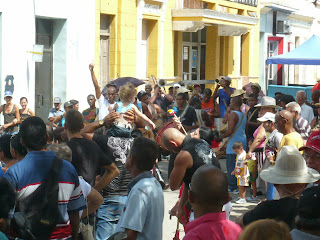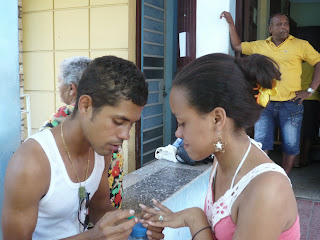One of the aspects of Cuban revolutionary history which is
often considered "failed" was the attempt to create the "new
man" This ideal of Ché, among
others, envisioned a person (man was used to include humans of both genders
back in the 60s, although it really did mostly mean man) who would work and
sacrifice for the community in a disciplined and selfless manner without
thought of reward. It's true,
there aren't many of that sort of person around in Cuba or elsewhere. But is the "new person" an
entirely failed project? I don't
know.
 |
| Ché isn't just for tourists. He is revered in Cuba. One finds signs of this in unexpected places. |
A car decal, a tattoo on a young nurse's hand...
 |
| Look, son, it's El Ché! |
What I do know is that the
streets of Havana are enormously
safer than those of any other big
city I've ever been in. (I've never been to Scandinavia, among other places.)
It's routine to get a helpful response from people, even as a visitor, and it
is also clear that neighbors are routinely helpful to each other and share, for
example, their telephones. The large public celebrations also used to puzzle me
- how was it possible for so many people to crowd together and drink so much
without a fight starting every minute?
 |
| the beer wagon at Carnaval |
Obviously the Cuban reality is very complex, nuanced, and in flux, so that anything one writes is an over-simplification, and maybe temporary too.
But there are some noticeable differences, even now more than 50 years post-Revolution and about 20 after the worst of the Special Period, compared to the US. In Cuba cooperation is the norm and fierce competitive acquisitiveness is not seen as desirable, but as deviant behavior. (This is an over-simplification about the US also - I live in a rural community where cooperation is normal, but it is obvious that this does not reflect the economic life of the nation.) Random hostility and violence are not common in Cuba, even in big cities.

It has been alleged, and some studies show, that highly competitive societies promote sociopathic behavior. Since the absence of mercy and morals offers advantages in achieving business success, this becomes adaptive behavior. Perhaps the Cuban achievement is not to have formed the communist new man but to have resisted the creation of the capitalist neoliberal new man and to have allowed people's natural humanity to remain intact.
 |
| Long time comrades, in every sense of the word. |
 |
| Electricity outage (apagón) causes this woman to work in the courtyard. |
 |
| These men fought under Ché's command. |
 |
| restoring a car |

|
Zaida and her combatientes medal. The men in the photo above are also wearing these. Not all revolutionaries have beards.
Vilda Figueroa and Pepe Lamas are the Proyecto Comunitario Conservacion de Alimentos. The previous post is about this.
The project is actually now rated "Triple Excelencia."
The Tercera Edad (Elders) Group eating at noon.
The community supply of drinking water is also at Martin Luther King Center.
It would be impossible to list all of Pastor Raul Suarez's achievements in a long essay, much less in a photo caption.
He has shared leadership for making a vibrant church in Pogolotti, for building the Martin Luther King Center and all its programs, for forging a connection with Pastors for Peace, for creating a Baptist liberation theology, for changing the attitude of the Cuban Revolutionary government about religion, and so much more. He is truly one of the great men of the 20th Century.
He was also wounded at Playa Girón, where he went to aid the casualties of the failed US-sponsored invasion.
Lázaro Ostelaza volunteered for the Cuban army in Angola. The Cuban help in defeating the forces of South Africa was important in ending apartheid.
 The kids are all right. The kids are all right.
|



 It has been alleged, and some studies show, that highly competitive societies promote sociopathic behavior. Since the absence of mercy and morals offers advantages in achieving business success, this becomes adaptive behavior. Perhaps the Cuban achievement is not to have formed the communist new man but to have resisted the creation of the capitalist neoliberal new man and to have allowed people's natural humanity to remain intact.
It has been alleged, and some studies show, that highly competitive societies promote sociopathic behavior. Since the absence of mercy and morals offers advantages in achieving business success, this becomes adaptive behavior. Perhaps the Cuban achievement is not to have formed the communist new man but to have resisted the creation of the capitalist neoliberal new man and to have allowed people's natural humanity to remain intact.





















